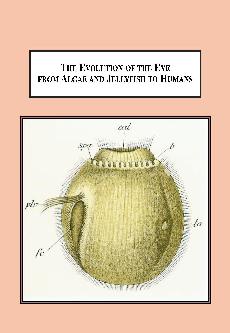Evolution of the Eye From Algae and Jellyfish to Humans: How Vision Adapts to Environment

| Author: | Hudson, Arthur J. | |
| Year: | 2010 | |
| Pages: | 176 | |
| ISBN: | 0-7734-3699-2 978-0-7734-3699-5 | |
| Price: | $159.95 + shipping | |
| (Click the PayPal button to buy) | ||
Reviews
From the Foreword - Prof. Bessie Borwein, Associate Dean Medical Research, University of Western Ontario
"This is a book that will appeal to all students of the visual system from beginners to the most advanced. It is also a book that will be of great value to scientists studying one or another aspect of the eye in living things. Without question, it is the most up-to-date compendium on eye structure available today and researchers wishing to put their work in context with the wonderful world of vision will find its contents invaluable. This is a book that will last and in the years ahead one can expect that it will continue to add value both as a superb reference text and a “must read” for the average person interested in science and the eye."
Prof. Martin J. Hollenberg, Dean Emeritus of Medicine, The University of British Columbia
"[An] exceptionally well-researched and precisely written work by an accomplished academic neurologist... Readers from several related fields will value this unique work as a thorough and comprehensive source of information and insight into this extensive field."
Prof. Warren T. Blume, University of Western Ontario
"The book is valuable, in part because it gives a compact yet detailed survey of the varieties of eye design and also because culminates in the proposal of some thought-provoking hypotheses aimed at tying together the evolutionary history of vision. ... The book ultimately serves as a thoughtful, if cursory, overview of eye evolution, and Hudson deserves credit for filling the rather large gap in book-length treatments of eye evolution." -- Prof. Daniel Graham, Hobart and William Smith Colleges
Table of Contents
Introduction
Chapter 1: The Beginning of Life on Earth
1. Darwin and Evolution of the Eye
2. Solar Energy as the Source of Life
3. Photosynthesis
4. Rhodopsin
Chapter 2: Eyespots and the Earliest Forms of the Eye
1. Euglena
2. Warnowiidae (Warnowiaceae)
3. Bryozoa
The Visual System of Bryozoa Evolutionary Changes in Larval Bryozoan Eyespots Hydrozoan Jellyfish Scyphozoa Jellyfish Cubomedusan Jellyfish Bivalves (Shellfish) Gastropods (Snails)
Cephalopods
Nautilus (Primitive Cephalopod)
Advanced Cephalopods (Octopus, Squid and Cuttlefish) Platyhelminthes (Flatworms)
Nematoda (Roundworms)
Annelida (Segmented Worms) Refraction Reflection
Rhabdom Lightguide
Pigment Cells (Shading Pigments)
Color Filters
Nervous System
Dorsal Simple Eyes
Lateral Simple Eyes
Apposition Eyes
Simple Apposition Eye
Afocal Apposition Eye
Neural Superposition Eye
Superposition Eyes
Refracting Superposition
Reflecting Superposition
Parabolic Superposition Side Eyes (AL and PL) Principal Eyes (AM) Light Refraction by the Cornea and Lens Multifocal Optics in Terrestrial Vertebrates On-center and Off-center Organization of the Retina
Rod and Cone Cell Pathways to the Ganglion Cells Variations in the Retinal Chromophore Frogs and Toads (Anurans)
Salamanders (Urodeles) Turtles (Chelonia) Crocodiles and Alligators (Crocodilians) Lizards (Lacertilia) Snakes (Ophidia) Monotremes Marsupials General Features The Human Eye The Invertebrate (Insect) Eye The Vertebrate (Mammalian) Eye Similarities in Larval and Embryonic Development The Luria-Delbrück Hypothesis The Cairns Hypothesis F? Episome Mutagenesis Opposition to the Directed Mutation Hypothesis Chromatin and DNA Interrelationship
Epigenetics and Its Influence on Memory
4. Concluding Remarks
Chapter 3:
Aquatic Invertebrate Eyes
1. Jellyfish
2. Molluscs
1. General Features of the Compound Eyes
2. The Parts of the Compound Eye
3. Refraction, Reflection and the Rhabdom as a Lightguide
4. Simple Eyes
5. Compound Eyes
6. Possible Evolutionary Change to a Vertebrate Eye
Chapter 5:
Crustacean Eyes
1. Nauplius Eye
2. Crustacean Compound Eyes
Chapter 6:
The Eyes of Spiders
1. Net-casting Spiders
2. Jumping Spiders (Salticidae)
Chapter 7:
Vertebrate Eyes
1. Molecular Properties of the Lens
2. Photoreceptor Cells in the Retina
3. Rhodopsin and the Color Vision Opsins
4. Electrical Circuitry of the Retina
5. Protective Pigment Layers of the Retina
6. The Choroid
7. Ocular Design for Animal Needs
Chapter 8:
The Eyes of Fish and Other Marine Vertebrates
1. Fish Eyes and the Water Environment
2. Lampreys (Cyclostomes)
3. Sharks and Rays (Elasmobranchs)
4. Bony Fish (Teleostea)
Chapter 9:
Eyes of Amphibia, Reptiles and Birds
1. Amphibia
2. Reptiles
3. Birds
Chapter 10:
Mammals
1. Monotreme and Marsupial Eyes
2. Placental Animal Eyes
3. Development of the Eye: Larva versus Embryo
Chapter 11:
Genetic Control Mechanisms in the Evolution of the Eye
1. Directed or Adaptive Mutations
2. Epigenetics and Gene Silencing
3. RNA-Directed Gene Silencing
4. Horizontal Transfer of Transposons
Chapter 12:
Conclusions
References
Index
